How asparagus grows: growing and caring in open ground for beginners
Dining room asparagus - a relative of indoor asparagus. This is a valuable and nutritious vegetable crop. Its tasty sprouts contain vitamins A, C, group B, iron, calcium, sodium, magnesium, manganese, copper and selenium. Although asparagus is a demanding crop, its cultivation does not require serious material and physical costs.
In this article we will look in detail at how to grow asparagus yourself.
How asparagus grows in the garden
The first thing a summer resident who decides to plant asparagus should learn is that he will receive a tasty harvest only in the third year of cultivation. This is explained by the biological characteristics of the plant.
To plant asparagus, choose a sunny place, protected from drafts. Sandy and poor soils are not suitable. The ideal soil is loose, has neutral acidity, and is rich in humus.
Reference! Asparagus is a delicacy, comparable to artichokes and truffles.
Photo of how asparagus grows:
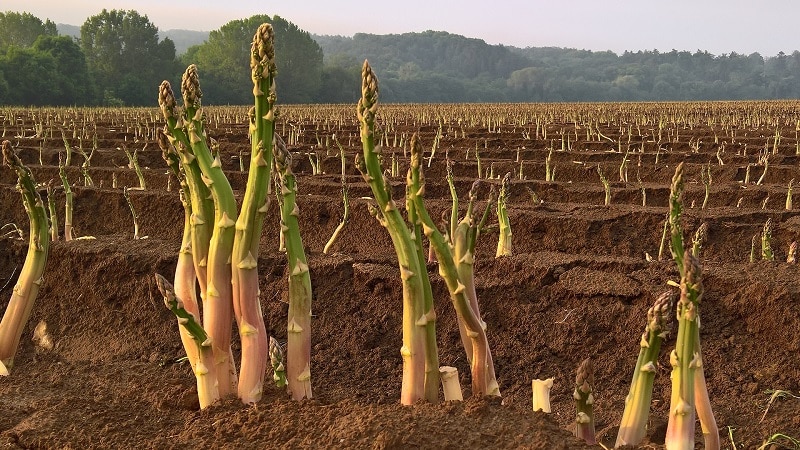
Landing dates
Before planting asparagus, the soil is pre-prepared. The seeds of this vegetable crop can withstand even severe frosts, so asparagus is sown both in spring and before winter.
in spring
The asparagus bed is dug up, rotted manure (5–8 kg per m2) is added, and lime is added to neutralize the acidic soil. If the soil is heavy, it is loosened with peat or sand.
When sown at the end of April, seedlings will appear after the May holidays.In early spring, average daytime temperatures are relatively low, the soil does not have time to dry out and asparagus sprouts quickly. The culture loves space: only 4 plants fit per 1 m2.
Planting pattern: 30 cm between plants and 60 cm between rows.
in autumn
When sowing asparagus in winter, organic matter is not added to the soil.
When digging up the ground, add a mixture of mineral fertilizers (per 1 m2):
- superphosphate - 60 g;
- potassium sulfate - 30 g;
- ammonium sulfate - 20 g.
The planting pattern is the same as in the spring. A small embankment is formed above each row of crops, as in hilling. This will protect the crops from frost.
Reference! In one place without transplants asparagus grows up to 20 years.
Seed preparation
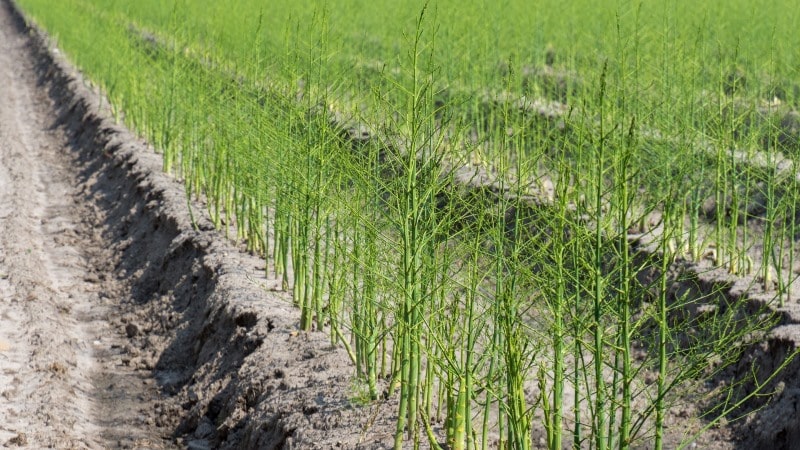
Asparagus seeds have a dense shell. This factor prevents the crop from sprouting quickly and vigorously. To make plants germinate faster, the seeds are pre-treated. There are several ways to “wake them up”:
- Scarification of the seed coat. Take fine-grained sandpaper and lightly file down the shell of the planting material.
- Soaking in warm water for 2-3 days. Every morning the water is replaced with fresh water. The tissue is kept warm (the optimal temperature for germination is +22...+24°C). After this, the seeds are placed in damp sand or sawdust for 7 days. During this period they hatch.
Asparagus is grown by seedlings and without seedlings. In the first option, sowing is carried out in March - February. Seedlings grow slowly, reaching only 15 cm in 1.5 months. If it is not possible to grow seedlings in apartment conditions, the seeds are planted in the ground in late May - early June.
Planting seeds in open ground
Seeds are planted in a bed with loose, light mechanical composition and fertilized soil according to the following scheme:
- embedment depth - 1-2 cm;
- distance between plants - 5–7 cm;
- Row spacing is 25–30 cm.
Attention! After sowing asparagus, be patient: the delicacy will sprout within 30–45 days.
Further care
Asparagus spears emerge in early spring and can be white, purple, pinkish-white or green. This depends not only on the characteristics of the chosen variety, but also on the growing conditions and harvesting time.
Young shoots are thinned out, leaving the strongest and healthiest. In the first year, asparagus is not replanted so that it develops a good root system and becomes stronger. The crop is transferred to a permanent place after 1-2 seasons.
Growing and caring for asparagus in open ground includes standard agricultural practices:
- Timely watering — asparagus does not like both dry soil and stagnant water.
- Regular feeding — a month after germination, asparagus is fertilized with mullein infusion (1:5). After harvesting, a mixture of mineral fertilizers consisting of superphosphate, urea and potassium salt is applied annually.
- Weeding weeds - they must be removed in the first year, otherwise weak asparagus sprouts will simply die.
- Loosening top layer of soil after watering and weeding.
- Hilling — the color and taste of the edible part depend on this. They consume green and bleached shoots. Green asparagus does not require hilling. Every spring, fertile soil is added to it (a layer of 5–7 cm). To produce white sprouts, mounds of ridges are made over the asparagus in early spring. The height of the mulching ridge is at least 25–30 cm. Dry sawdust is used as mulch.
In autumn, asparagus shoots are cut off close to the ground. To protect the roots from freezing, they are covered with straw, sawdust or peat for the winter.
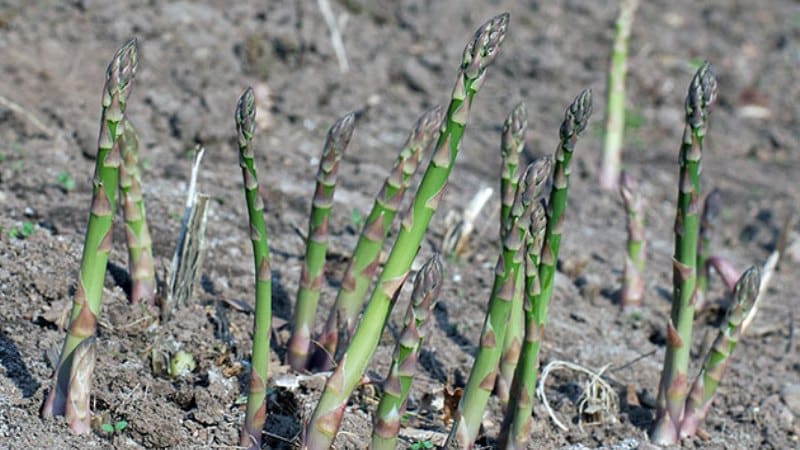
Disease and pest control
The most dangerous pests for crops are:
- Asparagus leaf beetle - a small dark blue bug with a thin red border on the back. The beetle attacks plants in the spring, eating leaves and shoots. In one season, pests produce 2-3 generations. If you do not fight them, you may be left without a harvest.
- Asparagus fly - a small brown fly, up to 7 mm long. The adult lays eggs in asparagus shoots. The eggs hatch into larvae that develop inside the stems, actively eating away at the core part. Edible fleshy shoots lie down and turn black. In the middle zone, the fly is rare, distributed mainly in the south of Russia, in Ukraine and Georgia.
- Asparagus rattle - a black-red beetle with white or yellowish dots on the back (from 6 to 12 depending on the variety). Distributed in the south of Russia. Overwinters on asparagus shoots.
The simplest, but most ineffective way to combat insects is to collect them by hand. Plants are sprayed with mustard or dry ash.
The following drugs have proven themselves as chemical protection against pests: Actellik, Tagore, Lambda-S. The latter kills insects in a matter of minutes.
Asparagus diseases usually arise due to errors in care and deteriorating weather conditions (excessive watering, prolonged rains, high humidity combined with low air temperatures):
- Fusarium. In June, asparagus branches turn yellow, wither and dry out. At the base of the stem, purple or brown spots with a white fluffy coating are noticeable on the shoots.
- Rust. Yellow-brown spots appear on the stems, protruding above the leaf surface. Diseased bushes lag behind in development and do not produce new growth. At the end of summer they turn yellow earlier than others.
- Cercospora blight. Gray spots with a dark coating and a red-brown border appear on the leaves.
- Red root rot. In infected asparagus, the root collar and roots die. These parts of the plants are covered with a red web - the hyphae of the fungus.
All diseases are caused by various types of fungi. If the infection is not severe, a single treatment with Fundazol is sufficient. Dosage - 20 g per 10 liters of water. After treatment, the affected area is covered with plastic wrap. In case of severe infection, a new plantation will have to be started.
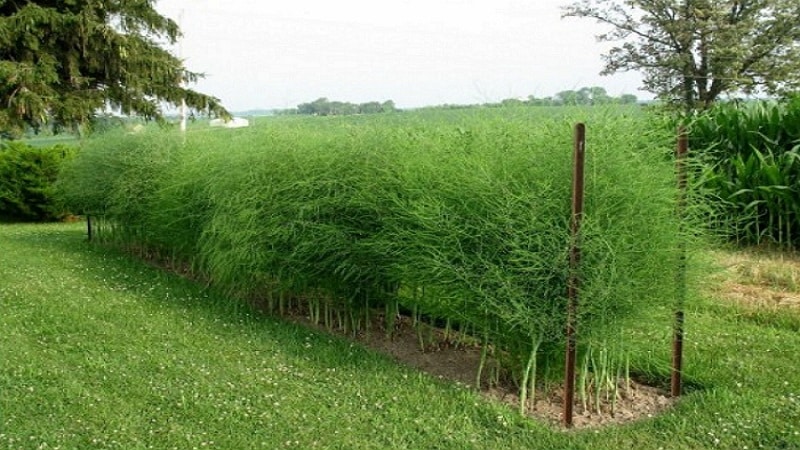
For preventive purposes against fungal diseases, it is recommended:
- annual application of biological products to the soil (Fitosporina, Trichodermina);
- processing the crop in spring and autumn with a solution of Bordeaux mixture;
- uniform watering;
- regular mineral nutrition (lack of potassium and excess nitrogen increase the susceptibility of the crop to many fungi);
- drainage of a site with close groundwater.
Important! Chemicals are used only after collecting edible shoots.
Harvesting
In the third year of life, asparagus harvests its first harvest. Cutting begins in early May, before the plant heads open. When growing bleached asparagus, its location in the earthen mounds is determined by the cracks in the ridge. In their place, carefully rake the soil and cut off the white shoots. Cutting is carried out in the morning or evening, once every 2 days.
In the first year of harvesting, no more than 5 stems are removed from one bush so that the plants do not become depleted. Mature bushes produce up to 30 shoots over the entire season.
How to store it correctly
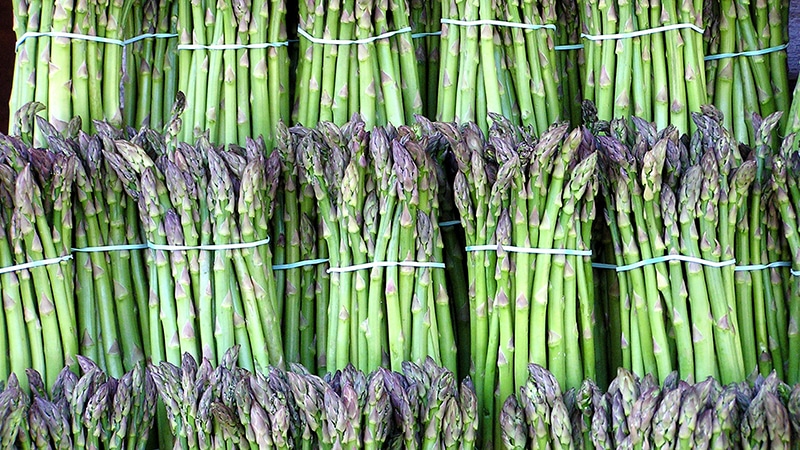
The harvested asparagus is wrapped in a clean, damp cloth and placed in the refrigerator. Asparagus can be stored for up to 1–3 months. To increase the shelf life of the crop freeze or preserve in brine.
Important! In the refrigerator, asparagus is placed vertically so that it does not deform, away from strong-smelling foods.
Reproduction methods
Vegetative propagation of asparagus is much more effective than sowing in the ground. In this case, more than 80% of planted plants take root and take root.
By division
Small but thick, well-developed horizontal rhizomes are suitable for propagation. In early spring, they are cut into 2-3 parts so that each bears 2-3 buds. The sections are sprinkled with crushed coal. Each plot is planted in a permanent place in soil prepared in advance.
Cuttings
During mass propagation of asparagus from March to June, cuttings are taken from last year's shoots. Everyone should have 3-4 kidneys. Chopped branches are planted for rooting in sand and covered with film to create a greenhouse effect.
In the morning and evening, the cuttings are ventilated and sprayed with warm water. They take root in 30–40 days, after which the plants are transplanted into pots or immediately to a permanent place.
Important! To ensure quick survival of cuttings, their lower sections are powdered with Kornevin.
Features of forcing
To enjoy asparagus in winter, in late autumn it is dug up along with a lump of earth. This is done only when all the shoots have dried out.
The root ball is planted in a large box (container, pot) with fertile soil. Required container parameters: length and width - 50 cm; depth - 20–30 cm. The rhizomes are straightened and sprinkled with the same soil. Plantings are watered abundantly and covered with film to retain moisture. The optimal room temperature is +18…+20°C. The harvest will ripen in 1.5 months.
The best varieties for open ground
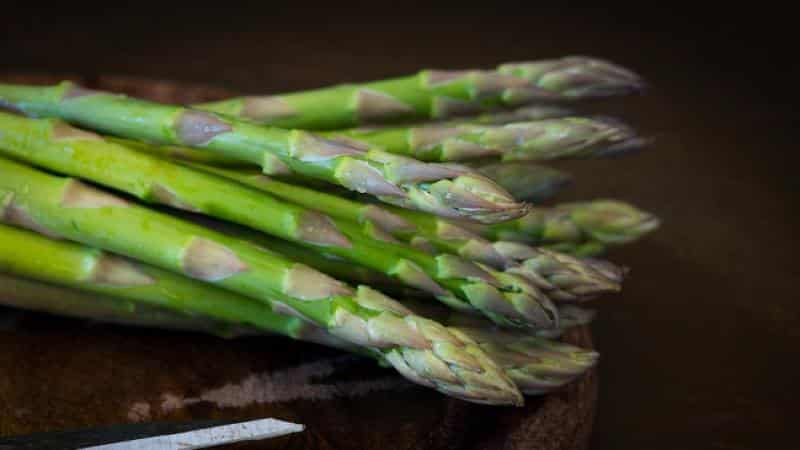
To cultivate asparagus in summer cottages, breeders have developed many varieties and hybrids:
- Argenteuilskaya - early ripening and the only variety recommended for forcing at home. It is distinguished by large, low-fiber, white shoots. Ripens in early May. Asparagus is frost-resistant and productive.
- Early yellow - an early ripening variety of Russian selection with yellow shoots and milky tender pulp.
- Tsarskaya - produces white thick (up to 2 cm) and tall (up to 16 cm) shoots. Features of the variety: drought resistance, frost resistance, high resistance to fungal diseases.
- snow head - mid-season asparagus with greenish-pink shoots. The scales are pale purple. The pulp is tender, similar in taste to green peas.
- Martha Washington - an interesting mid-early variety with violet or reddish-purple color of the shoots. Resistant to rust, recommended for cultivation in regions with high humidity and greenhouse forcing.
- Glory of Brunswick - a late variety, characterized by long white shoots. Productivity is high - up to 12 shoots per season from one plant. Ideal for canning.
Conclusion
Asparagus is often grown in the country as an ornamental plant, but in vain: the agricultural technology of this vegetable crop is quite simple, including standard techniques (watering, fertilizing, hilling, loosening).
Asparagus is planted both in spring and before winter, monitoring soil fertility, and preventing diseases and pests. The harvest of tasty and healthy sprouts is harvested only for the 3rd year.